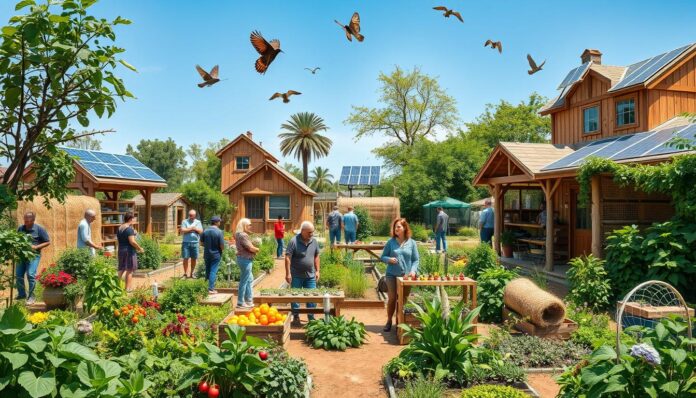Did you know the Sharing Economy is seen as the internet’s third phase? It moves from sharing info to using social media. TIME Magazine named it one of the 10 ideas that will change the world. It’s about sharing, reusing, and recycling resources, promoting sustainable practices and community exchange.
This model can be improved by permaculture principles. These principles focus on designing sustainable and regenerative systems.
The permaculture sharing economy centers on sharing goods, services, and skills. It promotes environmental responsibility and social connectivity. By using permaculture in the sharing economy, we can make a system that’s good for people and the planet.
This approach values access to resources over owning them. It reduces waste and fosters a culture of community well-being and trust.
Key Takeaways
- The Sharing Economy is a growing trend that promotes sustainable practices and community exchange.
- Permaculture principles can be applied to the sharing economy to create a more sustainable and regenerative system.
- The Sharing Economy emphasizes access to resources over ownership, reducing waste and promoting social connectivity.
- Environmental responsibility is a key aspect of the permaculture sharing economy, ensuring that value creation and distribution are aligned with natural resource availability.
- The permaculture sharing economy promotes a culture of community well-being, health, trust, and sustainability, emphasizing diversity and collaboration.
- The Sharing Economy has the potential to change the way we live, work, and interact with each other and the environment.
Understanding Permaculture Principles
Permaculture is a design system that focuses on regenerative agriculture. It aims to make food production and resource use more sustainable. By following permaculture, people and communities can share resources better, leading to collaborative consumption.
The idea of permaculture is built on three main ethics: caring for the earth, caring for people, and investing in these goals. It teaches us to think deeply about our relationship with nature. We learn to share resources in an eco-friendly way, supporting sustainability. For more on permaculture ethics, check out permaculture practice.
Defining Permaculture
Permaculture is a complete design system. It works to make regenerative agriculture practices better. It aims for sustainable and eco-friendly food production and resource use.
The Ethics of Permaculture
The three core ethics of permaculture are:
- Care of the earth
- Care of people
- Reinvestment in those ends
Core Design Principles and Practices
Permaculture’s design principles and practices focus on collaborative consumption. They help share and use resources efficiently. Key principles include:
- Observe and interact with nature
- Catch and store energy
- Obtain a yield
What is the Sharing Economy?
The sharing economy lets people share goods, services, and skills with tech help. It’s become popular as a green choice over buying new things. It helps cut waste, makes things more efficient, and builds stronger communities.
At its heart, it’s about linking people and resources to help the planet. Sharing means using less new stuff, which cuts down on waste. It’s a step towards living more sustainably.
Key Characteristics of the Sharing Economy
- Sharing of goods, services, and skills
- Facilitated by technology
- Emphasis on sustainability and community building
The Role of Technology in Sharing
Technology is key in the sharing economy. It helps people find and share resources online. Sites like Airbnb and Uber let you share homes and cars, encouraging sharing over buying.
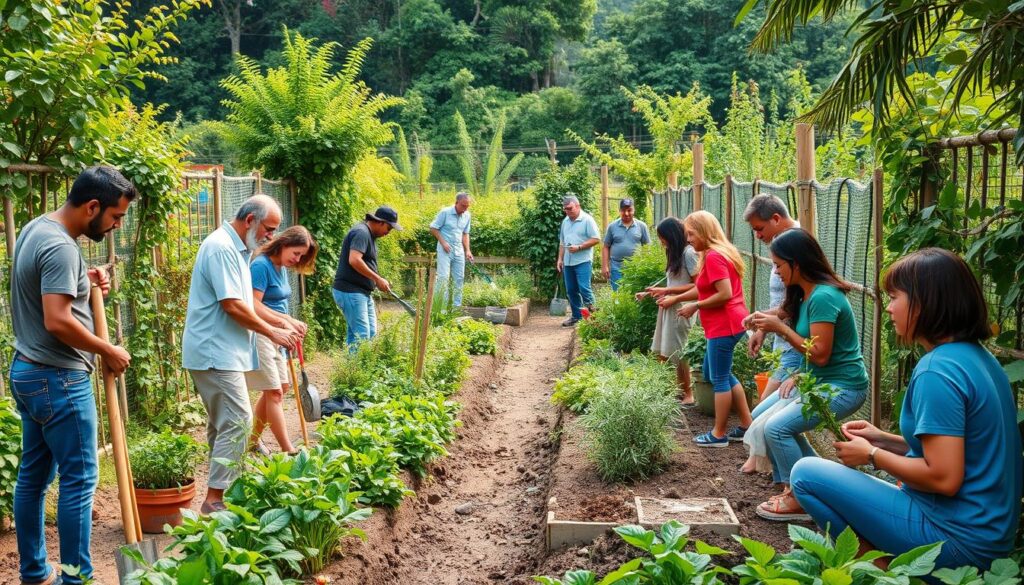
By joining the sharing economy, we help make our communities greener and stronger. It’s a way to live more sustainably and reduce our impact on the environment.
| Platform | Description |
|---|---|
| Airbnb | Accommodation sharing platform |
| Uber | Ride-sharing platform |
| Getaround | Car-sharing platform |
Intersection of Permaculture and Sharing Economy
The idea of permaculture sharing economy aims to make our world more sustainable. It combines permaculture’s principles with the sharing economy. This way, people can make their communities stronger and more sustainable.
By working together and sharing resources, we can use less and waste less. This leads to a more efficient and greener way of living.
Permaculture sharing economy brings many benefits. It boosts food security, community engagement, and environmental sustainability. It encourages everyone to live in a way that’s good for the planet and fair for all.
There are many ways to make permaculture sharing economy a reality. For example:
- Starting community gardens and urban farms
- Creating tool libraries and sharing resources
- Supporting local food cooperatives and community-supported agriculture
These efforts help build stronger, greener communities. They show us a better way to live together and care for our planet.
Why Choose a Permaculture Sharing Economy?
A permaculture sharing economy brings many benefits. It promotes sustainability and uses resources wisely. By sharing, people can lessen their impact on the environment. This helps build a stronger, more connected community.
Some key benefits include:
- Less waste and pollution from sharing and reuse
- More access to resources and services
- Deeper community bonds and social connections
Joining a permaculture sharing economy means you’re part of something big. It’s about valuing community resilience and caring for our planet. This way, we can build a fairer, greener economy where everyone benefits.
Real-World Examples of Permaculture Sharing Economy
The permaculture sharing economy is more than just a theory. It’s a real movement happening globally. For example, local food cooperatives let members share resources and skills. This way, they can grow and share fresh, organic food. It’s a great way to show regenerative agriculture in action, supporting both the environment and the community.
Tool libraries are another example. They let people share tools, cutting down on waste. This idea is at the heart of the green living movement. It encourages creative ways to share and reduce our environmental footprint.
These examples show how the permaculture sharing economy works in real life. It helps build alternative economic systems that focus on sustainability, community, and fairness. By sharing, people can work together to make our food systems more resilient and fair for all.
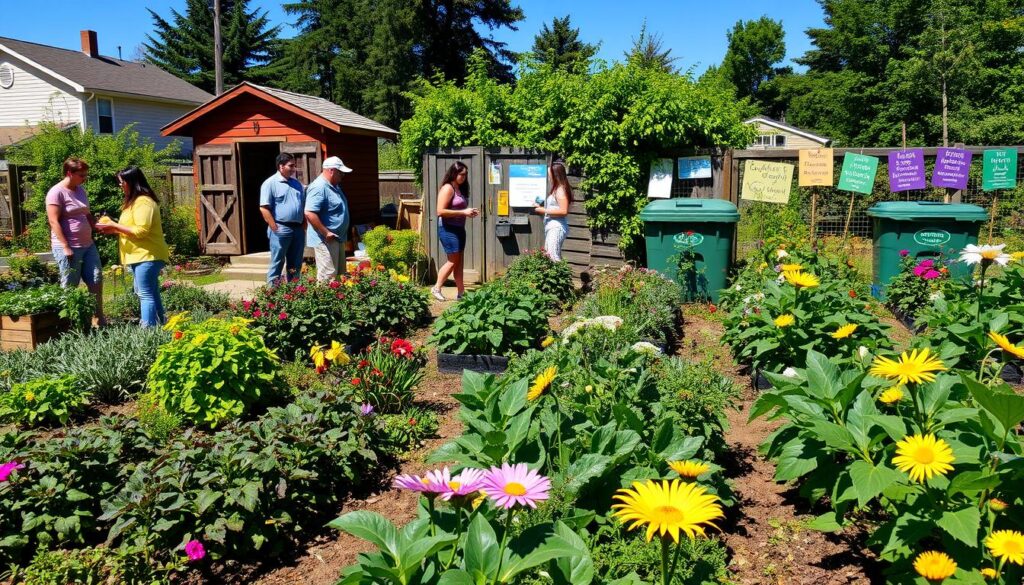
- Increased access to fresh, organic food
- Reduced waste and environmental impact
- Promotion of sustainable farming practices
- Support for local communities and economies
The permaculture sharing economy is a unique way to share resources and build communities. It puts sustainability, fairness, and caring for the environment first.
| Example | Description |
|---|---|
| Local Food Cooperative | A member-based organization that produces and distributes fresh, organic food |
| Tool Library | A platform for sharing tools and equipment, reducing waste and promoting resource sharing |
Challenges in Implementing Permaculture Sharing Economy
Starting a permaculture sharing economy faces many obstacles. One big issue is regulatory problems. These can slow down collaborative consumption and alternative economic system growth. For example, zoning laws and licenses can block community-supported agriculture and sharing projects.
Another big challenge is getting people involved. Building community resilience needs everyone’s help and teamwork. But, it’s hard in places with little resources or where people don’t know about permaculture sharing economy benefits.
To beat these hurdles, we need to find ways to boost collaborative consumption and community resilience. This could mean education, community events, and teaming up with local groups. Together, we can create a stronger, more resilient economy for all.
Strategies for Promoting Permaculture Sharing Economy
To promote the permaculture sharing economy, we need to focus on education and digital platforms. Teaching people about sustainable practices and community exchange helps more join in. This way, we can grow the permaculture sharing economy.
Here are some ways to promote the permaculture sharing economy:
- Organize workshops and webinars on permaculture.
- Create online spaces for sharing resources and knowledge.
- Partner with local groups to support permaculture projects.
The permaculture sharing economy can change how we live and interact with nature. By using permaculture sharing economy ideas, we can cut down waste and build stronger communities.
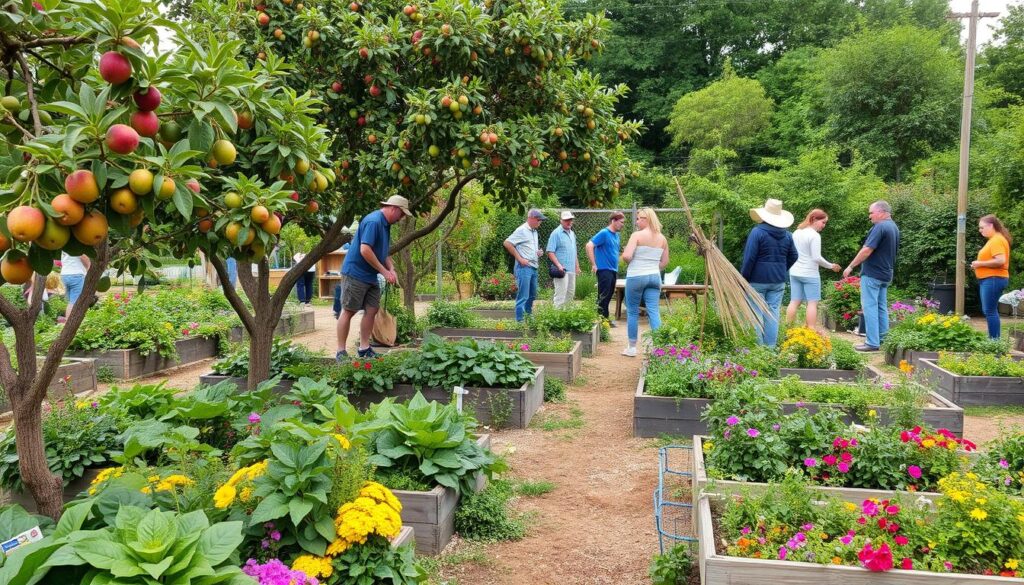
Together, we can make a more sustainable and fair world. The permaculture sharing economy is a key to better community exchange and sustainable practices. It’s up to us to bring it to life.
| Strategy | Benefits |
|---|---|
| Education and outreach | More people will know about and join the permaculture sharing economy. |
| Digital platforms for collaboration | They help us talk and share resources better. |
| Partnerships with local organizations | They give more support and resources for permaculture projects. |
Case Studies in the United States
In the United States, there’s a growing interest in regenerative agriculture and eco-friendly sharing. The Fall Farm Crawl in southern Illinois is a great example. It brought together twenty farms from five counties.
This event showed off local produce, wines, and ingredients. It showed how working together can help rural economies.
Some important facts from the event are:
- Two USDA certified organic farms took part
- Eighteen farms used sustainable farming methods
- There were two vineyards and wineries, plus one craft brewery
These examples show how regenerative agriculture and eco-friendly sharing help rural areas and farming. By using permaculture and working together, communities can build a better food system.
As more people want sustainable practices, supporting these efforts is key. Together, we can make a food system that’s good for both cities and countryside.
The Role of Local Governments and Policies
Local governments and policies are key in supporting permaculture and resource sharing. They help build community resilience. By promoting sustainable practices, they encourage a green living movement.
Creating an alternative economic system is one way to do this. This system values sharing and working together. Local governments can offer incentives for green practices, like tax breaks.
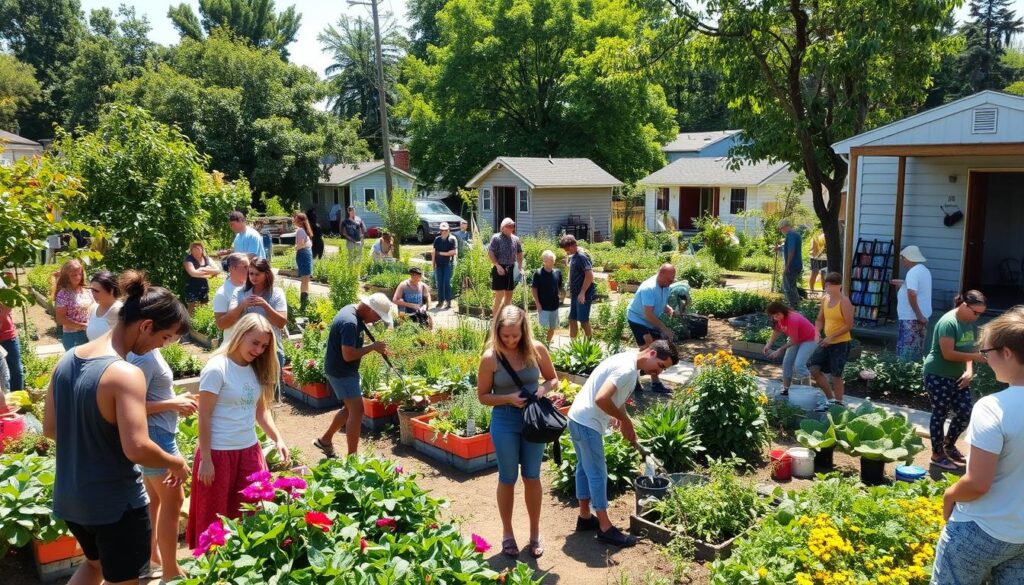
- Implementing community garden programs
- Creating bike-sharing systems
- Establishing tool libraries and resource sharing platforms
These efforts make our community stronger and more ready for environmental challenges.
Future Trends in Permaculture and Sharing Economy
The permaculture sharing economy is growing fast. It’s thanks to new sustainable practices and a focus on community exchange. A report by the Institute for the Future says the U.S. will see more sharing economy after the pandemic. It will also see well-being as a basic right.
Some key trends in the permaculture sharing economy include:
- Increased focus on sustainable practices, such as regenerative agriculture and circular economy models
- Growth of community exchange programs, including local food cooperatives and tool libraries
- Integration of permaculture principles into various sectors, including healthcare and manufacturing
These trends come from a growing need for sustainable practices and community exchange. This is because of climate change and economic uncertainty. As the permaculture sharing economy grows, it will play a big role in sustainable living’s future.
A cultural shift towards a sharing economy is possible. This shift is about changing how we share resources. It’s driven by the importance of community exchange and sustainable practices for a fair and green future.
| Trend | Description |
|---|---|
| Sustainable Practices | Regenerative agriculture, circular economy models |
| Community Exchange | Local food cooperatives, tool libraries |
| Permaculture Principles | Integration into healthcare, manufacturing, and other sectors |
How to Get Involved in Your Community
Getting involved in your community is a great way to join the permaculture sharing economy. You can do this by joining local initiatives, volunteering, and networking. This helps with collaborative consumption and builds community resilience. Start by looking for local food cooperatives, community gardens, or initiatives that support the green living movement.
Here are some ways to get involved:
- Starting or joining a local community garden
- Volunteering at a food cooperative or other community initiative
- Participating in local workshops or events focused on sustainable living
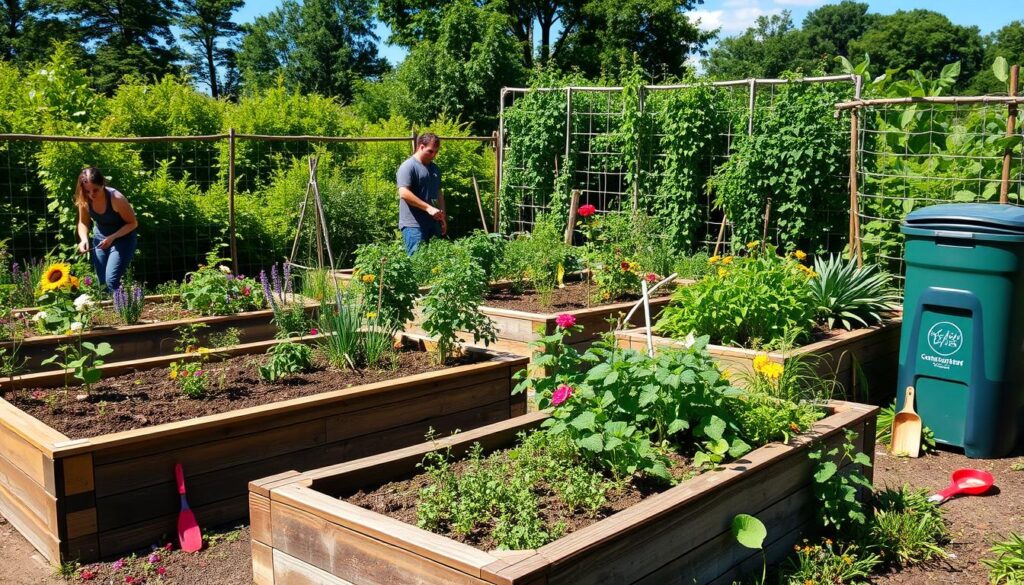
By getting involved, you help make our food system more sustainable and resilient. You also meet people who share your values and build a stronger community. Remember, every small action adds up, and together we can make a big difference.
Measuring Success in Permaculture Sharing Economy
To measure success in a permaculture sharing economy, we look at a few key areas. These include the use of regenerative agriculture, the growth of eco-friendly sharing, and the building of an alternative economic system. These help us see how the economy affects the environment, social bonds, and economic strength.
Some important signs of success are:
- More food grown and less waste
- Better water use and management
- More diverse ecosystems and services
- Stronger local economies and jobs
- Deeper social connections and community involvement
A thriving permaculture sharing economy also shows in the number of people involved. It’s seen in the variety of skills and resources shared. And it’s felt in the sense of community and cooperation. By monitoring these signs and sharing stories of success, we can grasp the full impact of the permaculture sharing economy. This helps us strive for a more sustainable and fair future.
| Indicator | Metric | Target |
|---|---|---|
| Food production | Tons of food produced per year | 10% increase annually |
| Water conservation | Gallons of water saved per year | 20% reduction annually |
| Biodiversity | Number of species supported | 15% increase annually |
Resources and Further Learning
If you’re curious about permaculture and the sharing economy, there’s a lot to explore. You can find books, articles, online courses, and workshops. These resources offer insights and practical knowledge on living sustainably and building community.
Books by pioneers like Bill Mollison and David Holmgren are great starting points. They’ve written a lot about permaculture. You can also learn by taking online courses or attending workshops from places like the Permaculture Institute and the Sharing Economy Association. These offer hands-on training in permaculture design and community building.
Recommended Reading and Courses
- Permaculture: A Designer’s Manual by Bill Mollison
- The Sharing Economy: A Guide to Collaborative Consumption
- Online courses on permaculture design and sustainable practices
Online communities and forums are also great for learning. Places like the Permaculture Forum and the Sharing Economy subreddit are perfect for discussing and sharing knowledge with others who are interested in permaculture and the sharing economy.
| Resource | Description |
|---|---|
| Permaculture Institute | Offers online courses and workshops on permaculture design and sustainable practices |
| Sharing Economy Association | Provides resources and support for individuals and organizations involved in the sharing economy |
Conclusion: Envisioning a Sustainable Future
The permaculture sharing economy is key to a better future. It combines collaborative consumption, community strength, and green living. This way, people and groups can help make the world regenerative.
Permaculture teaches us to live in harmony with nature. It shows how to design our lives and work with the environment. When we add the sharing economy’s focus on sharing and working together, we get a powerful mix.
Looking to the future, the possibilities are endless. Picture cities filled with green gardens, tool libraries, and networks of people helping each other. By working together, we can change how we use and share resources. This leads to a fairer and greener world.
It’s time to take action. Start a composting project, join a food cooperative, or share your skills with others. Every action you take helps us all move towards a better tomorrow. Let’s work together to make a world where permaculture and sharing thrive.

